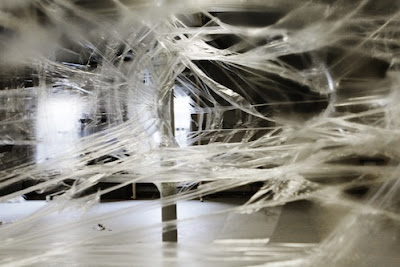Webspinners (Embioptera order) are a small group of mostly tropical and subtropical insects. Their common name comes from the insects' ability to spin silk from structures on their front legs. They then use the silk to make a web-like pouch or gallery in which they live.
The silk is produced in spherical secretary glands in the tarsi of the insects' forelimbs, and can be produced by both adults and larvae. Some species of webspinners are estimated to have up to 300 silkglands: 150 in each forelimb. These glands are linked to 'setae-like cuticular process called a silk ejector', and their exceedingly high numbers allow individuals to spin large amounts of silk very quickly, creating extensive galleries. The silk web is produced throughout all stages of the webspinners lifespan, and requires very little energy output.
The ‘galleries' produced by webspinners are tunnels and chambers woven from the silk they produce. These woven constructions can be found on substrates such as rocks and the bark of trees, or in leaf litter. Some species camouflage their galleries by decorating the outer layers with bits of leaf litter or other materials to match their surroundings. The galleries are essential to their life cycle, maintaining moisture in their environment, plus offering protection from predators and elements while foraging, breeding and simply existing. The only occasion when an embiid will leave the gallery complex is when winged males fly out or wingless males walk out in search of a mate, or when females explore the area immediately surrounding them in search of a new food source.
Webspinners continually extend their galleries into new food sources, and expand their existing galleries as they grow in size. The insects spin silk by moving their forelegs back and forth over the substrate, and rotating their bodies to create a cylindrical, silk-lined tunnel. Older galleries have multiple laminate layers of silk. Each gallery complex contains a number of individuals, often descended from a single female, and forms a complex maze-like structure, extending from a secure retreat into whatever vegetable food matter is available nearby. The size and complexity of the colony varies between species, and they can be very extensive in those species that live in hot and humid climates
How could this be applied to design? The webspinners' way of designing their galleries can be applied to designing larger-scale tensile structures, as they strive to minimize the use of material and produce the most effective structural forms.
You can experience a webspinner-like gallery yourself at Färgfabriken until next week. They have an interesting installation called TEJP Stockholm (Tape Stockholm) by Numen.
The installation is a series of galleries hanging in the air, all made from clear packaging tape. Visitors can go inside the galleries and experience the atmosphere of the thin structure.
Don't miss it, especially if you're going there for the miljonprogrammet Seminar tomorrow! It's super cool, fun and and educational at the same time! The installation closes on March 17th.
More information at: www.fargfabriken.se.jpg) |
| Photos: Sara Mac Key via färgfabriken.se |
// Satu
.jpg)
.jpg)
No comments:
Post a Comment